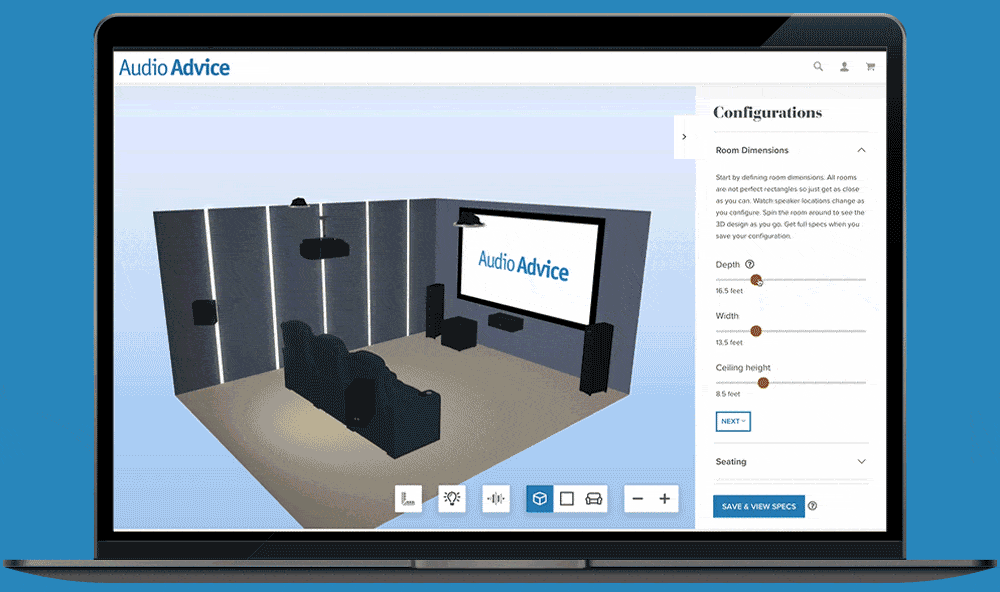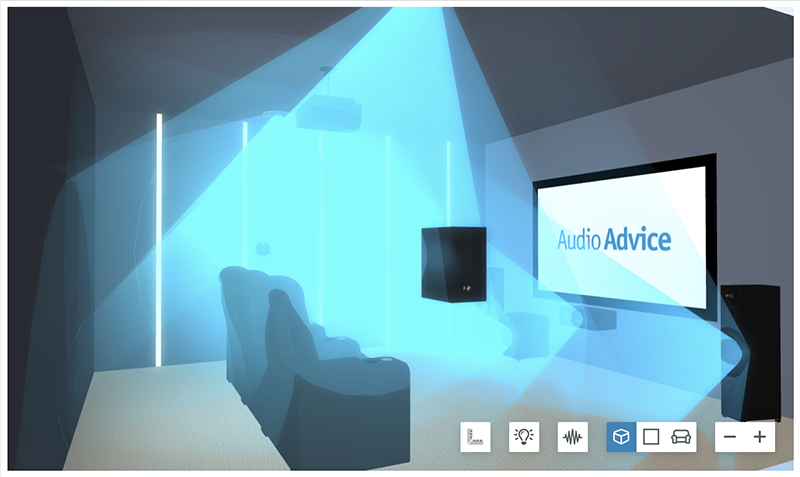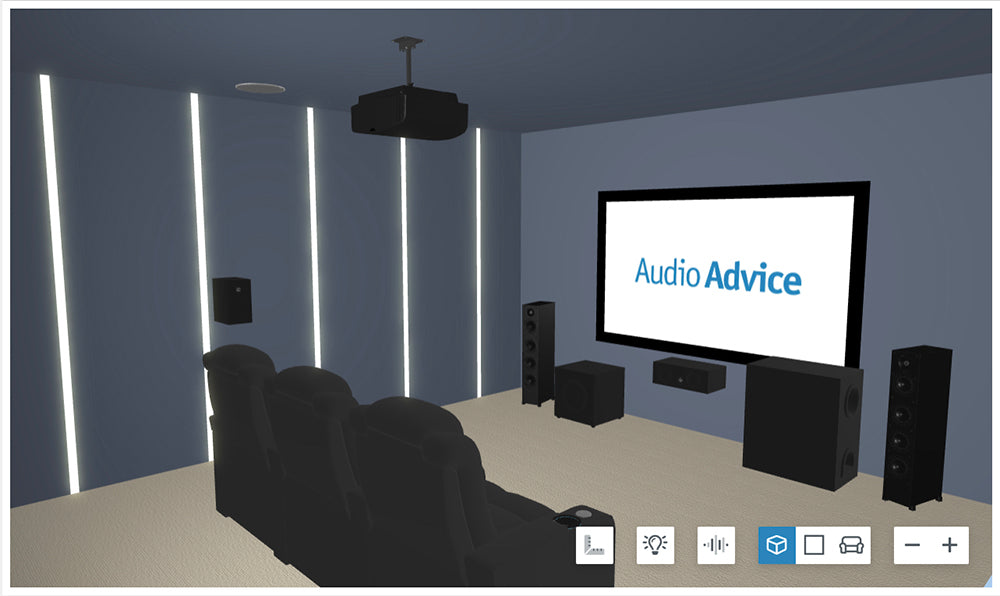In Issue 160 we covered the useful Home Theater Designer loudspeaker setup software developed by Audio Advice, an audio/video retailer and systems integrator with showrooms in Raleigh and Charlotte, North Carolina. This free online interactive utility makes it easy to determine the optimum speaker placement for a stereo or surround system.
The user enters the room size and information like the number of speakers, the size of the video display, the number of seats in the room and other factors, and Home Theater Designer then provides 3-D visualizations and recommended speaker setup distances and measurements. The “virtual room” display changes as you enter information, and you can even grab objects in the room with your mouse and they’ll move, and the measurements will be updated in real time.
Our interview with Audio Advice CEO Scott Newnam continues here.
Russ Welton: Most Copper readers won’t realize that Audio Advice is the fastest-growing audio consumer electronics company in the US. Where have you experienced your greatest growth?
Scott Newnam: We are generally seeing relatively consistent growth across all product categories in the audio and home theater spaces.

Scott Newnam of Audio Advice.
RW: Do you recall your first hi-fi system?
SN: I had a JVC full rack and tower speaker system when I was in college, which I bought from Circuit City.
RW: What is your personal favorite format for music listening and why?
SN: I use Roon to stream high-resolution music in my office where I have my two-channel system. However, I am now really starting to enjoy music mastered in Dolby Atmos in my home theater. If you love music and have not heard good Atmos tracks yet, it is definitely worth trying.
RW: How important is a good stereo setup when building upon it into a home theater?
SN: I use my home theater room for both stereo listening and movies. Obviously when you do this, you really want your stereo speakers and setup to be as good as possible. Then you fill out the rest of the system from there.

Demo of Audio Advice’s Home Theater Designer software.
RW: When do you feel is it better to run stereo speakers full-range plus a subwoofer – let’s say in a 2.1 or 2.2+ configuration – compared to having the speakers crossed over and letting the sub handle most of the low frequencies? Is it only if you’re using super-low-extension main speakers?
SN: There are multiple theories on this. Ultimately you want to accurately reproduce the sound intended by the engineers. In my living room system, I have two bookshelf speakers that I play full range, taking advantage of their natural bass rolloff, and then I have matching subs hidden below them that augment low bass and even subsonic frequencies. It works great in that system. However, in my theater room I have full tower speakers, but I use the surround-sound processor to [determine] the crossover [point] to the subs, for the ideal blending of the subs and the mains. In this situation, crossing over leads to a much better-blended stereo experience. In most systems, if your preamp can [perform bass management of] the crossover [point] between the subs and the main towers, I feel you are generally better off doing it that way versus running full-range to your left and right plus a subwoofer.
RW: What are some of your best suggestions for adequate/appropriate cable length runs when using multiple subwoofers? Also, what are your feelings about Wi-Fi-controlled subs?
SN: If you have good cable, most lengths are not an issue. However, if you really want super-high performance, Wi-Fi-controlled subs can create a challenge. Getting all of your subwoofers time- and phase-aligned makes a massive difference in the audio experience. Wi-Fi not only adds delay, but the delay also can vary over time. If you put four subs in a room and the two in the back are Wi-Fi-enabled, you will have to add substantial delay to everything else to account for the Wi-Fi delay [to the rear subwoofers]. But you cannot account for the real-time variances of the Wi-Fi delay. So wire your subs if you can.
RW: Are the delay implications of DSP-equipped subwoofers more difficult to manage in small rooms than non-DSP subs?
SN: For most DSP-equipped subs, the perceptible delay is relatively constant. If you are using a 2-channel system that has no ability to delay the main speakers, then DSP-equipped subs can be an issue for time alignment. If, however, you have delay or distance-adjustment capability in your processor, then you can adjust for the delay in the subs by making the distance setting longer.
RW: How would you advise adjusting DSP delay in milliseconds according to room size? Is one foot per millisecond usually correct for each discrete channel?
SN: For the average person, adding one foot of extra distance in your processor settings for each millisecond of delay is a good solution. However, if you really want to nail it or you don’t know the exact delay of your DSP, then you can search for “Audio Advice subwoofer calibration” on YouTube, where I show you how to do it.
RW: What do you foresee as the next biggest development in object-oriented sound modeling for the future? (Object-oriented sound mixing enables sound sources to be placed in a virtual listening space.)
SN: Right now, specifications like Dolby Atmos provide relatively wide ranges of speaker placement. Obviously, when movies are mastered, the engineers know exactly where they want the car to zoom through the room. So, I expect we will continue to see more speakers used in systems and a tightening of specification ranges so that what the listeners experience is closer and closer to the original vision.
RW: Do you have any advice for accommodating wildly differing source material if your stereo is also part of your home theater? E.g., different movies, or live music Blu-ray or DVD discs, or music files.
SN: Increasingly, really good preamp/processors allow you to set up different speaker profiles in their calibration settings. So, for instance, I have a profile for movie watching that has room-calibrated all of my speakers across a handful of seats for when my family is watching a movie. However, I have a second profile that uses just my front left and right speakers crossed over to my subs and is calibrated across just our main two listening seats. This second profile provides a much superior stereo listening experience than listening using the first profile in stereo, both because the microphone calibration measurement positions were tighter around the primary listening seats, and because the equalization and phase alignment was done using just those speakers.

Home Theater Designer software showing speaker dispersion, side view.
RW: Tell us about how your Home Theater Designer software has been built with the different surround sound and immersive audio specs factored in.
SN: We looked at all of the major standards, such as Dolby, Auro 3-D, and DTS:X, and attempted to design the tool to achieve the best outcome across them. We also went one step further, which was to help users find the optimal positioning within those standards. So, for instance, if you are using Home Theater Designer and you remove your side speakers, you will see the rear speakers push out wider within the specification ranges to create a more immersive experience. Add the side speakers back and you’ll see the rears move tighter and away from the surrounds, to achieve optimal 3D immersion.
RW: What question do audiophiles very rarely consider that they should?
SN: As audiophiles we often get too caught up in the specifications and measurements. Ultimately, what we want is fabulous sound. As we get older, we might need an increasingly less-flat response curve from our system to achieve the perceived sound that was intended and that we enjoy. So, don’t be afraid to test adjustments that might theoretically produce slightly too much bass or high frequencies if the end result sounds better to you.



